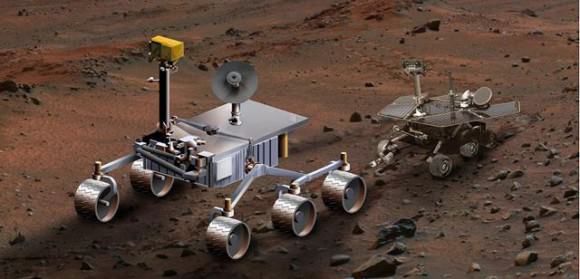[/caption]
NASA’s next Mars rover, the Mars Science Laboratory, or Curiosity, is scheduled to launch from Cape Canaveral in Florida in late 2011, and arrive at a yet undecided region of Mars in August 2012. The goal of Curiosity is to assess whether Mars ever had an environment capable of supporting microbial life and conditions favorable for preserving clues about life, if it existed. JPL put together a list of five intriguing things about Curiosity:

1. How Big Is It?: The Mini Cooper-sized rover is much bigger than its rover predecessors, Spirit, Opportunity and Pathfinder. Curiosity is twice as long (about 2.8 meters, or 9 feet) and four times as heavy as Spirit and Opportunity, which landed in 2004. Pathfinder, about the size of a microwave oven, landed in 1997.

2. Landing–Where and How: In November 2008, possible landing sites were narrowed to four finalists, all linked to ancient wet conditions. NASA will select a site believed to be among the most likely places to hold a geological record of a favorable environment for life. The site must also meet safe-landing criteria. The landing system is similar to a sky crane heavy-lift helicopter. After a parachute slows the rover’s descent toward Mars, a rocket-powered backpack will lower the rover on a tether during the final moments before landing. This method allows landing a very large, heavy rover on Mars (instead of the airbag landing systems of previous Mars rovers). Other innovations enable a landing within a smaller target area than previous Mars missions.
For more info about the landing site selection, see this JPL article.
3. On-board Toolkit: Curiosity will use 10 science instruments to examine rocks, soil and the atmosphere. A laser will vaporize patches of rock from a distance, and another instrument will search for organic compounds. Other instruments include mast-mounted cameras to study targets from a distance, arm-mounted instruments to study targets they touch, and deck-mounted analytical instruments to determine the composition of rock and soil samples acquired with a powdering drill and a scoop.
4. Big Wheels: Each of Curiosity’s six wheels has an independent drive motor. The two front and two rear wheels also have individual steering motors. This steering allows the rover to make 360-degree turns in-place on the Mars surface. The wheels’ diameter is double the wheel diameter on Spirit and Opportunity, which will help Curiosity roll over obstacles up to 75 centimeters (30 inches) high.
5. Rover Power: A nuclear battery will enable Curiosity to operate year-round and farther from the equator than would be possible with only solar power.
For more about Curiosity see the NASA webpage about the Mars Science Lab.
Source: JPL


Now THAT’s a cool looking dune buggy! Am a tad concerned about the complexity of the ‘Sky Crane’ landing concept though… hope it works!~
It’s got a laser that can VAPORIZE ROCKS???? AWESOME!!!
Come on, Martian hordes, we can handle ya. 😀
Looking forward to a nuclear battery option for my iPhone.
Looking forward to a nuclear battery option period. This is AFAIK the last source material bar the Jupiter Europa Orbiter, unless the Congress gets its act together. No more around-the clock mars rovers or outer solar system probes! (This is presumably why the Jupiter Ganymede Orbiter and ExoMars rover is solar powered.)
Please, please, please write your congress man, if US citizen.
Wow. As big as a Mini Cooper. Now that is a serious explorer. Something this size should last longer, go further and carry far more equipment than prior rovers. This ought to be the start of ‘serious’ extra-planetary exploration. Great news indeed. Perhaps the next one will be as big as a Mondeo and seat two humans. [I realise a Mondeo will resonate with UK-only readers].
“congress man” – “congressman” or, the dictionary tells me, “member of congress/representative”.
Paul, the next one is the ExoMars rover, and it is 1/3 the mass. It uses the same new landing platform though.
My uninformed guess is that it is the RTGs that makes large rover’s ROI. (Besides ESA being the poor relative, of course.)
Good grief, the development stage 1B of ExoMars looks like something the Soviets built in the 1960’s to land on the moon. Will it be steam-powered do you think?
the descent process looks complicated. I hope all goes well.
@ND
I agree. Hopefully, we’ll have a better system for landing on Mars before a manned mission. Still, exciting news. Now we need robotic landers to explore Titan, Europa, and Enceladus. Perhaps not so far away with the development of nuclear batteries?
Paul, I believe so; the rumor is it works on hydrogen and captured and perchlorate, the panels are mainly for wind sailing the gusts. Europe loves its future steam punk technology!
You might be surprised at just how much Victorian engineering attracts visitors/tourists and still actually works here in Britain. There are many, many swing-bridges and river crossings which date from the the mid-late 19th century and are in regular use. There is also a thriving steam heritage where people maintain and run steam trains, traction engines as well as working turbines, pumps etc from the 18th century. That’s why Beagle 2 was a private venture and the size of a dinnerplate.[Gods, no wonder we’re a third world country!! 😉 ]